
What You Want Out of Your Partners
The recent purchase of the startup TaskRabbit by IKEA offers up a really great example of what happens when an idea finds its perfect corporate catalyst. Your organization is in a position to do something similar—as long as you do your homework.
Sometimes, a business story comes so far out of left field that you’re not sure what to think about it at first.
The tale of Swedish furniture giant IKEA acquiring startup TaskRabbit, a sharing-economy service that allows you to hire help for different tasks, was kind of like that. At least until you actually unpack it, that is.
IKEA, of course, is a great company, one that famously makes its furniture just a little bit cheaper by requiring its buyers to do most of the assembly—unless you want to hire an outside company to do it, one like, you guessed it, TaskRabbit. IKEA probably realized the acquisition was a natural opportunity to solve a problem with its existing business model.
As deals go, it’s certainly more obvious than Amazon buying Whole Foods. And, as Wired points out, this deal isn’t even actually unique. IKEA’s online-only competitor Wayfair partnered with a company called Handy, which offers a similar service to TaskRabbit, just this year.
Now, to be clear, these startups aren’t perfect. Handy had to make a high-profile recalibration of its culture last year because it was causing both internal and external problems. (For one thing, no HR department.)
TaskRabbit, meanwhile, changed its entire business model from something akin to eBay to something akin to Uber—and earned some battle scars in the process of that messy transition. (It also came out ahead!)
And the hired-help startups have each faced legal problems, problems that could worsen based on what happens in a federal trial involving a related sector: food delivery.
But I do think that the way these companies found willing collaborators in massive-yet-complementary firms highlights the ways that a good partnership can be found within the startup community. Not an acquisition—a partnership.
This year has admittedly been a weird one for startups. In the last 12 months, companies like Juicero and Bodega have found themselves the subject of unflattering press for having products that seemed to cost too much, over-relied on engineering (in the case of Juicero), and were insensitive to the product’s impact on the existing market (in the case of Bodega). Those are the ones that seem to get all of the attention. But, on the other hand, there are many other startups, be they small companies or fast-growers, that may have benefits to your organization given the right context.
It is important to point out what “partnering” really means, however. It doesn’t mean just downloading an app and using its software. It doesn’t mean getting attached to a piece of software that doesn’t have a business model. It means, when discovering an idea or tool you like, finding a tangible way to integrate it into your business—not only using a company’s tool, but publicly supporting it, sharing feedback with the firm, and turning the transaction into a partnership, not just an exchange of funds and services.
This is what IKEA did. Last year, the company actually partnered with TaskRabbit in the startup’s one international market, London, making it the standard way to get someone else to build your Knislinge sofa. The partnership apparently worked so well that IKEA took the relationship a bit deeper.
Forbes contributor Blake Morgan, a customer experience futurist, notes that the approach might even give IKEA a more personal touch in the future.
“Ikea can now use TaskRabbit to spend more time with customers in their homes. Ikea can help customers build furniture—and a variety of related tasks,” she wrote. “It seems to be more profitable for Ikea to ship these large cases of disassembled pieces all over the globe, and have local gig economy workers put it together in the customer’s home.”
That’s not to say your organization will love something so much that you’ll jump into acquisition talks. That said, I think that, as great as it is to build something internally, there may be even better ideas happening outside of your doors—ideas that your organization could make better by either putting them in front of the right people or by leveraging that technology internally.
Maybe it means you spend a little more time hanging around the 1776 startup incubator, which has become a favorite of both associations and their more established corporate partners. Maybe it means doing a few demos or getting someone on the phone.
But if your organization wants to continue to evolve, it’s important to look around for great ideas and then use those ideas to drive your decision-making process.
Because, hey, you might just get lucky and find a partner with just the right tools to get the job done.
(Tommy Alvén/iStock Editorial/Getty Images Plus)






Comments